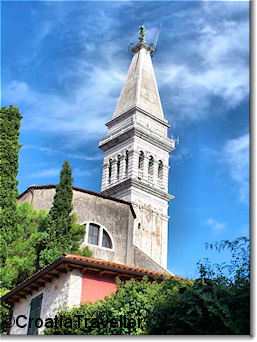Ancient Rovinj
Founded as an island town cradled under a small hill, Rovinj was first mentioned as an ancient town in the early 8th century (as Ruvignium, Ruvigno, Ruignio) although it had probably been in existence for several centuries already.
Medieval Rovinj
In the 6th century, Rovinj was under Byzantine rule, followed by Frankish rule in the late 8th century and then was ruled by the Aquilean patriarch. Throughout, a strong maritime industry was developing and in 1188 Rovinj signed an important pact with the reigning naval power, Dubrovnik.
Venetian Rovinj
Meanwhile, Venice was rising in importance and began eying Rovinj as an outpost for supplying, resting and repairing its damaged ships. Rovinj, along with other Istrian towns, was increasingly threatened by piracy and in 1283, the town swore allegiance to the Venetian republic in exchange for protection.
It was not a happy marriage. The Venetians looked down on their Slavic subjects and Rovinj chafed under Venetian rule. Nevertheless, the town built up its infrastructure and managed to become an island of relative prosperity in the generally impoverished Istria. The bell tower of St Euphemia cathedral was built from 1654-1677 and was modeled after Venice's famous St Mark's bell tower. A number of other renaissance and baroque palaces testified to Rovinj's prestige.
It was at this time that Rovinj's unique chimneys emerged. Newcomers had to build their homes literally over the heads of the original settlers. Building a chimney was a legal condition of obtaining civil rights, so a forest of chimneys emerged.
At the end of the 17th century, the residents of Rovinj widened the town and finally filled in the isthmus that separated it from the mainland in 1763.
Fishing, maritime trade and shipbuilding were thriving industries in Rovinj until the rise of Trieste and Rijeka put an end to its maritime industry and shipbuilding eventually moved to Pula.
Austrian Rovinj
The fall of Venice in 1797 gave way to the Austrians as Rovinj's new rulers. In 1850, Rovinj became the seat for the Istrian chamber for trade and industry and in 1872 a tobacco factory was built that thrived for many years.
Italian Rovinj
From the end of WW1 until 1947, Rovinj was a part of Italy, further cementing the long Italian influence on its culture. When it was made part of Yugoslavia in 1947, many Italians fled.
Further Resources
Related Pages |

Rovinj's unique chimneys

St Euphemia
Join the Croatia Traveller Group
Recommended Experiences
©CroatiaTraveller 2005-2024 All rights reserved
